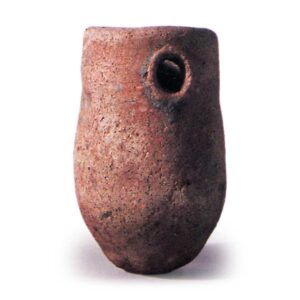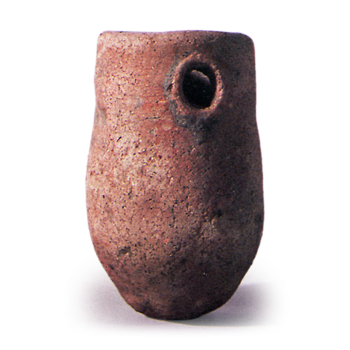
A tawara-ware jar used to catch octopi. It is a long jar about 30 centimeters high or less. It is submerged in the sea, and octopuses are pulled out and caught when they enter the jar, thinking it is a safe cave. While submerged in the sea, some octopuses would attach oysters to the outside of the jar or chloride due to the ocean tide, giving the jar a natural interest, which tea masters would use to make flower vases, water jars, etc.
Takotsubo-type earthenware
This small earthenware was used from the mid-Yayoi period to the Heian period as an octopus pot for cooking octopus and other items. It is found along the coast of the Seto Inland Sea, especially along the coast of Osaka Bay, and has also been found in Hakata Bay to the west and Mie Prefecture to the east. It is about 5 cm in diameter and 10 cm in height, and can be roughly classified into two types based on its shape. One is a round-bottomed cup with a slight bulge in the lower half and a hole near the mouth rim through which a rope could be threaded. Some of these types are known to have a hole in the bottom to allow for better drainage when pulled up. The other type is a small bell-shaped cup with a slightly tapered rim and a small protrusion at the top through which a rope could be threaded. In the mid-Yayoi period, cup-shaped octopus dumplings were used exclusively, and in the late Yayoi period, the improved tsuribane-shaped octopus dumplings appeared, and both types were used together thereafter. The only other examples of bell-shaped octopus pots produced after the ninth century were wheel-thrown. In the Middle Ages, large cylindrical octopus dumplings, which are thought to have changed from cup-shaped octopus dumplings, were used, and they have changed into various shapes in various regions up to the present day.
Takotsuri-toki (octopus fishing pottery)
RokuroIn Hashihama, Noma County, Iyo Province (Hashihama, Imabari City, Ehime Prefecture), there was a strange custom of fishing pottery with an octopus. Its origin is as follows. When Hideyoshi Kanjiro ordered Oda Yurakusai to seek out pottery for coffee shops in many countries, Yurakusai’s retainer Ueda Toemon had rare and unusual wares made at a pottery kiln in Kyushu and returned by ship. Fujiemon immediately went ashore and entered the house of a farmer named Mori, but Hideyoshi happened to die of illness at the same time. The captain of the ship, who was greedy by nature, took advantage of the time Fujiemon was ashore to sneak out and steal several hundred tea utensils, sink the ship, and disappear himself. Hearing this, Toemon committed seppuku (ritual suicide) as his crime was worthy of death, on October 9, 1598. The villagers created a small shrine in Karatsu Myojin to comfort the spirit of Toemon. Later, in the summer of 1827, a fisherman named Kujuro happened to catch an octopus holding pottery. He tied a thin rope to the octopus’s leg and released it into the sea. The octopus dropped to the bottom of the sea about 50 meters, where it tried to escape and was firmly attracted to the pottery. When the rope was pulled up at the right time of the tide, the pottery, which had been buried at the bottom of the sea, suddenly emerged, held by the octopus. Since then, the number of pottery salvaged in this way has been enormous. Some of the vessels had different colors on their surfaces, some were covered with oyster shells, and others were chlorinated by the ocean tide, giving them a natural appearance that was quite surprising.



